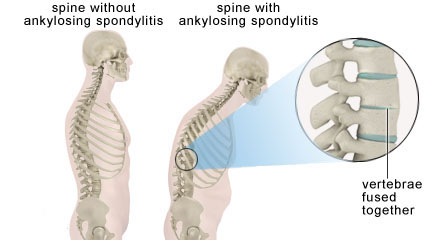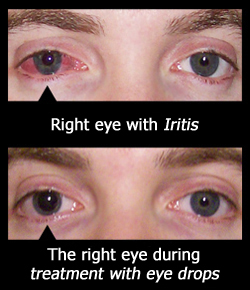What are the symptoms of Ankylosing Spondylitis?
AS is characterized mainly by inflammatory back pain (described below). Inflammation can occur in several areas, leading to pain and stiffness. These include:
- Sacroiliac and spinal joints
- Hip and shoulder joints
- “Peripheral” arthritis: smaller joint such as the hands, wrists, elbows, knees, and feet
- Joints involving the ribs, clavicle, and sternum and there attachments

Inflammatory back pain is usually reported in almost all AS patients. The characteristics of “inflammatory” back pain include:
- Pain at night (that improves with waking up and moving)
- Insidious onset
- Improves with exercise
- Does not improve with rest
- Age of onset < 40 years old
What are the symptoms of Ankylosing Spondylitis?
AS is characterized mainly by inflammatory back pain (described below). Inflammation can occur in several areas, leading to pain and stiffness. These include:
- Sacroiliac and spinal joints
- Hip and shoulder joints
- “Peripheral” arthritis: smaller joint such as the hands, wrists, elbows, knees, and feet
- Joints involving the ribs, clavicle, and sternum and there attachments
Inflammatory back pain is usually reported in almost all AS patients. The characteristics of “inflammatory” back pain include:
- Pain at night (that improves with waking up and moving)
- Insidious onset
- Improves with exercise
- Does not improve with rest
- Age of onset < 40 years old
Other bony symptoms include:
- Impaired spinal mobility: inability to fully bend at the waist or move the neck. Chronic, untreated disease can lead to fusion of the spine. Fusion at the cervical spine limits neck motion, fusion at the thoracic spine limits chest expansion (and breathing), and fusion of the lumbar spine limits the way a person sits and bends
- Abnormalities in posture: Patients can experience “hunching” of the back (hyperkyphosis) with long term disease, leading to a stooped posture
- Buttocks and hip pain: Which can alternate sides depending on the sacroiliac joint that is involved
- Enthesitis: inflammation at the attachment site of tendons and ligaments to bones that presents as pain and sometimes swelling. These include areas such as the Achilles tendon, the plantar fascia, and costochondral joints (cartilage of the ribs), and the superior iliac crest (areas of the pelvic bone)
- Dactylitis: Also known as “sausage digits”. This occurs in about 6% of patients with AS
Symptoms can also occur that are not related to the joints or bones, known as “extra-articular” symptoms. These can be related to the active disease or complications of AS, and include:


Symptoms can also occur that are not related to the joints or bones, known as “extra-articular” symptoms. These can be related to the active disease or complications of AS, and include:
- Uveitis: Also known as Iritis. It is inflammation of the anterior portion of the eye. It is a common manifestation in AS patients with up to 35% of patients experiencing this sometime in there disease course. It can occur in one or both eyes, and can “jump” from eye to eye. Can be a one-time phenomenon, or recurrent, and usually improves when the AS is treated effectively

- Lung issues: fibrosis of the lungs can occur from the inflammation (scar tissue formation), as well as restrictive lung disease from the inability to expand the chest
- Heart disease: There is an increased risk of heart disease and acute coronary syndromes due to the active inflammation of the disease. Other cardiac manifestations include aortitis (inflammation of the aorta), conduction abnormalities, and pericarditis (inflammation of the lining of the heart).
- Discitis: Inflammation of the vertebral discs
- Kidney disease: Nephropathy from antibody deposition (IgA) and secondary amyloidosis from chronic inflammation
- Neurologic conditions: Chronic inflammation and damage in the spine can affect the adjacent nerve roots or even the spinal cord itself
- Cauda equine syndrome: damage to the lumbar nerve roots leading to sensation changes in the legs, impotence, and bladder and bowel incontinence
- Spinal cord injury: mostly related to fractures, and can lead to paralysis
- Atlantoaxial subluxation: instability in the C1 and C2 vertebrae, leading to compression of the spinal cord, which can also lead to paralysis
MORE SECTIONS on AS
What is Ankylosing Spondylitis?
Diagnosis and Treatment of Ankylosing Spondylitis
ALSO SEE
References
https://www.rheumatology.org/I-Am-A/Patient-Caregiver/Diseases-Conditions/Spondyloarthritis
https://www.spondylitis.org/Ankylosing-Spondylitis
https://www.mayoclinic.org/diseases-conditions/ankylosing-spondylitis/symptoms-causes/syc-20354808






